Catocala of Washington
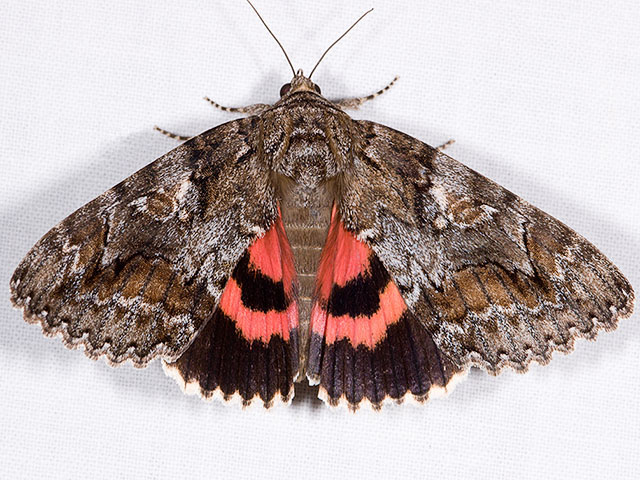
Catocala aholibah, Lyle-Balch Cemetery,
Klickitat County, Washington,
July, courtesy of John Davis
The following Catocala species are reported or
suspected from the state of Washington.
There is a good article on collecting these moths at night by
using bait at sugaring. The night
time photography can be spectacluar.
Most species also are attracted to mercury vapour and/or black lights.
During the day,
these moths rest with the hindwings covered; at night,
however, while feeding, the brilliant colours are often exposed.
See Tim Dyson Night Vision Photography.
This is also a great way to encounter other creatures of the night.
Observing these moths, often in the fall, is a good way to extend
your lepping season. The tiny eggs overwinter on tree bark.
The
larvae usually feed at night and descend tree trunks to hide in
leaf litter during the day. A nice little trick for finding the
larvae is to wrap the base of the tree trunk with a burlap sack
(towel will do) well after dark. When the larvae descend at dawn
they will hide in the burlap and can be uncovered during the day.
This list is compiled from the
Washington Natural Heritage Program site.
John Davis of Stevenson, Skamania County, southwestern Washington,
has recently sent me images of Catocala aholibah, Catocala californica,
Catocala relicta and
Catocala verrilliana from his county and nearby Klickitat County.
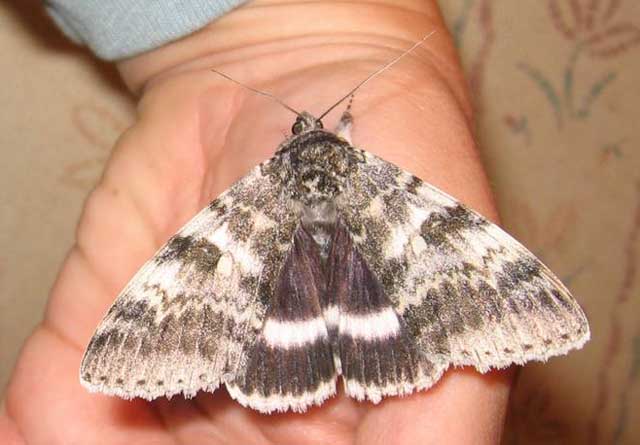
Catocala relicta, Spokane, Washington, September 1, 2008, courtesy of Zana Goulding.
Please report sightings to
Bill Oehlke. If you send electronic images, I can probably do
the ids. In most cases, however, I would need to see the specimen spread so that the hindwing black median band is
clearly visible, especially as it
approaches the inner margin. Wingspans are also a big help. That is the distance from one forewing tip to the other
forewing tip when
the moth has been spread so the forewing inner margin is perpendicular to the body.
I offer text descriptions to go with the thumbnail images below. if you are not already familiar with this genus and the
most important characters, it would be wise to
view the Identification Keys Diagram.
As of April 4, 2010, this page has been further updated as per research data compiled by Larry Gall.
I would like to continue to refine the listings to county levels so images and data (date, location at least to county level,
bait, lights) would be very much appreciated. Please send same to Bill Oehlke.
All images that I use on my websites remain the property of respective photographers and images are credited as such.
The Identification Keys Diagram should help you understand the terminology I have
used in describing the various species.
Visit Washington Sphingidae: Hawk Moths/Sphinx Moths.
aholibah yes, June until October; oaks *
briseis yes, July until September, probably northern only; willows and poplars *
californica yes, June until August; willow or poplar *
faustina yes, June until October; willows
faustina allusa yes, July-August; willows and poplars *, coastal
faustina cleopatra
grotiana yes, August until September; willows *
hermia yes, August until September; poplars and willows *
irene yes, July until September, probably southeast; poplars and willows *
junctura yes, May until October; poplars and willows *
relicta yes; June until October, probably N.& E; poplars and willows *
semirelicta yes, June until October; poplars and willows *
unijuga probably eastern, but no confirmed reports, June until October, willows *
verrilliana yes, July until September; oaks *
Small - Medium, Orange-Salmon-Pink Underwings: usually under 65mm
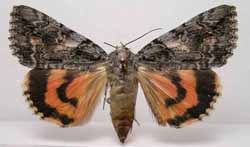
|
verrilliana; Verrill's Underwing;
45-60mm
Closed, subtriangular subreniform spot is large and
light in colour. Light patch runs from subreniform
diagonally to costa. Dark area on basal side of
am line and light patches between postmedian and subterminal lines
distinguish this species. Note orange hw fringe.
|
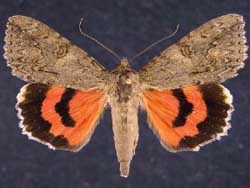
|
faustina;
58 mm
Forewing markings are relatively weak on almost uniform drab grey-brown ground colour.
The two middle "teeth" in the forewing postmedial line are relatively short.
The hindwing inner band is narrow and truncated well before the inner margin.
Black extenssions into white hindwing fringe continue as thin lines along veins.
|
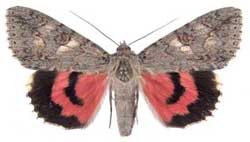
|
faustina cleopatra;
58 mm; Head and thorax dark bluish grey; abdomen brownish grey.
Primaries dark bluish grey. Transverse lines, reniform and sub-reniform indistinct with
some yellowish brown shading on upper surface.
Orange to pinkish hw with relatively narrow bands, fringe (unbroken) white on exterior margin, grey near abdomen.
|
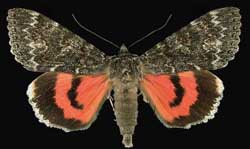
|
californica;
65-68mm.
Fws dark, gritty. Markings indistinct. Dark, large reniform spot; am/pm lines indistinct.
Subterminal line inwardly lined with light scales. Hw fringe white, checked in black halfway to outer edge,
black lines on veins extending through fringe. Some orange bleeding at apex. Hw black median line terminates
well before inner margin.
|
Catocala californica, Wenatchee, Chelan County, taken at wine bait, Pete Smytheman
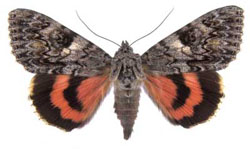
|
faustina allusa.
White interior outline of terminal line is typical of this species
and two jagged upper "teeth" of postmedial line are typical of most
poplar feeders. There is also a dark bar a few mm up from inner
margin of the forewing. Subreniform spot and area interior and above tend to be lighter. Coastal
|
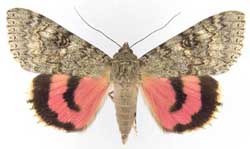
| Catocala hermia;
Hermia Underwing: 58-68mm; pinkish:
Fw almost uniform, grey-brown or clay coloured; thin, yet contrasting lines.
Distinct large double reniform spot. Large concolourous subrenifrom spot usually open.
Hw pinkish red, relatively even, narrow black bands. Inner black band ends before im.
Fringe white, checked, pink/red "bleeding" along outer band, near apex.
|
Medium - Large, Orange-Salmon-Pink Underwings: Wingspans: 65mm, usually 70-95mm
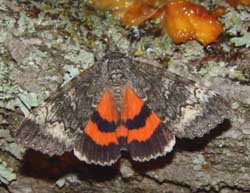
| #8817 briseis;
Briseis Underwing;
60-70mm.
Fws predominantly mottled dark-grey-brown with some lighter areas 1) between pm and subterminal lines,
2) at base of am and pm lines along
i. m., and 3) over subreniform spot running diagonally toward costa.
Pm lines lack greatly elongated, sharly pointed "teeth" near apex.
Hw fringe white, unbroken; inner black band (fairly even) reaches i. m..
Tim Dyson image. probably rare
|
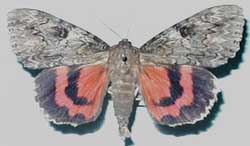
|
irene; Irene's Underwing;
65-75mm.
Fw grey brown, darker upper half basal area, around reniform spot, indistinct arc near apex.
Sbrnfrm spot lighter, open into pm area.
Hw median black band pointed before reaching im. Outer band scalloped near a. a..
Probably southeast; poplars, willows
|
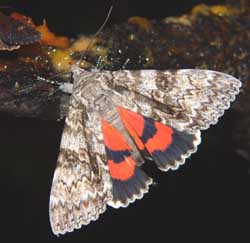
| ** 8821
semirelicta; Semirelict Underwing;
65-75mm
FW ground colour is whitish with dark lines and shadings.
Diffuse dark bar runs from center of basal area to outer margin a
few mm above anal angle. Note regular dentation of st line.
Hw inner black bar usually terminates well before
inner margin. The form "atala" has a forewing that is uniformly grey.
Unijuga is usually larger and has less contrasting black lines.
Inner black bar on unijuga usually reaches inner margin.
|
Catocala semirelicta, Wallula HMU, Walla Walla County, Washington,
August 1, 2009, Mike E. Denny
Catocala semirelicta, August 20, 2009, Mt. Spokane S. P., Spokane, John Baumann
Large Orange-Salmon-Pink Underwings: Wingspans: 70-90mm
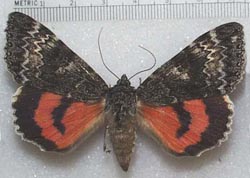
| Catocala grotiana;
Grote's Underwing: 70-80mm:
The white outlines outside the postmedial and inside the subterminal lines make this species stand out.
The hindwing inner black band is even and relatively thin and terminates well before the inner margin.
The fringe is heavily checked and charcoal grey along the inner margin.
Hindwings can be orange or red.
|
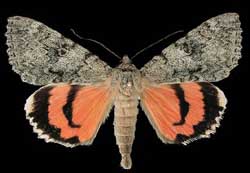
| Catocala junctura;
Joined Underwing; 67-85mm.
Fw is usually dark brownish-gray to evenly powdered
blue-grey w/o significant markings. Doubled reniform spot
often obscure. Thin, slightly darker am and pm
lines run from costa to im, not widely
spaced at im. Hw salmon/ orange-pink, narrow inner black band
turns in sharply, does not meet dark-haired im.
|
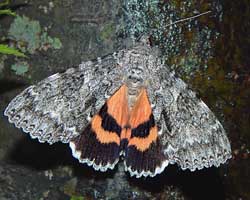
| ** 8805 unijuga;
Once-married; 70-90mm.
Fairly wide black inner band (almost reaching inner margin) in
hw and very distinctive patterning in fw. Meskei tend to
have narrower band and dustier (less distinct) looking forewing.
Semirelicta tend to have inner bands terminating well before
inner margins.
Note very white fringe on both forewings & hindwings.
Carroll Rudy image.
|
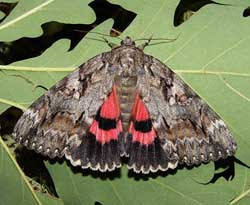
| aholibah;
80-90mm: Fw is mix of grey and brown, with preponderance of brown in subterminal area.
Double reniform spot has diffuse brown outline of inner oval. Subreniform spot is small,
distinctly outlined in black,
light coloured and does not connect to pm line. Upper two teeth of pm line are elongate
and are followed by relatively smooth line til next tooth below the subreniform spot.
Hindwing salmon or pinkish.
|
Large Black Underwings (Banded): Wingspans: 70-80mm
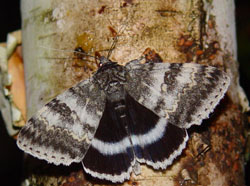
| ** 8803 Catocala relicta
;
Forsaken, White, Relict; 70-80mm:
Considerable variation with regard to black/white
concentrations on fws.
Typical specimens have basal and subterminal areas with
blackish scales.
Black hws, with brilliant even white inner band and
white fringe, are distinctive. June until October.
|
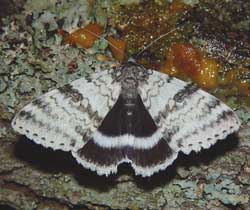
| ** 8803 Catocala relicta
;
Forsaken, White, Relict; 70-80mm:
Considerable variation with regard to black/white
concentrations on fws.
Form clara: basal and subterminal
areas predominantly white.
Typical specimens have basal and subterminal areas with
blackish scales. Black hws, with brilliant even white inner band and
white fringe, are distinctive. June until October.
|
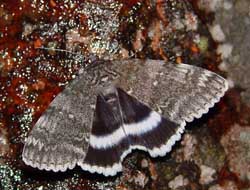
| ** 8803 Catocala relicta
;
Forsaken, White, Relict; 70-80mm:
Considerable variation with regard to black/white
concentrations on fws.
Form phrynia:
evenly dusted with grey over entire forewing.
Typical specimens have basal and subterminal areas with
blackish scales. Black hws, with brilliant even white inner band and
white fringe, are distinctive. June until October, poplars and willows
|
|
Use your browser "Back" button to return to the previous page.
Return to Canadian Index
Return to Main Index
Visit "Systematics of moths in the genus Catocala (Lepidoptera, Erebidae) IV.
Nomenclatorial stabilization of the Nearctic fauna, with a revised synonymic check list";
ZooKeys 39: 37–83 (2010) by Lawrence F. Gall, David C. Hawks
Enjoy some of nature's wonderments, giant silk moth cocoons.
These cocoons are for sale winter and fall. Beautiful Saturniidae moths will emerge the following spring and summer.
Read Actias luna rearing article.
Additional online help available.
Eggs of many North American Saturniidae species are offered during the spring and summer. Occasionally
summer Actias luna and summer Antheraea polyphemus cocoons are available. Shipping to US destinations is done
from within the US.
This page is brought to you by
Bill Oehlke and the
WLSS. Pages are on space rented from Bizland. If you would like
to become a "Patron of the Catocala Site", contact Bill.
Please send sightings/images to Bill. I will do my best to respond to
requests for identification help.

|

To show appreciation for this site, click on the flashing
butterfly to the left, a link
to many worldwide insect sites. |



